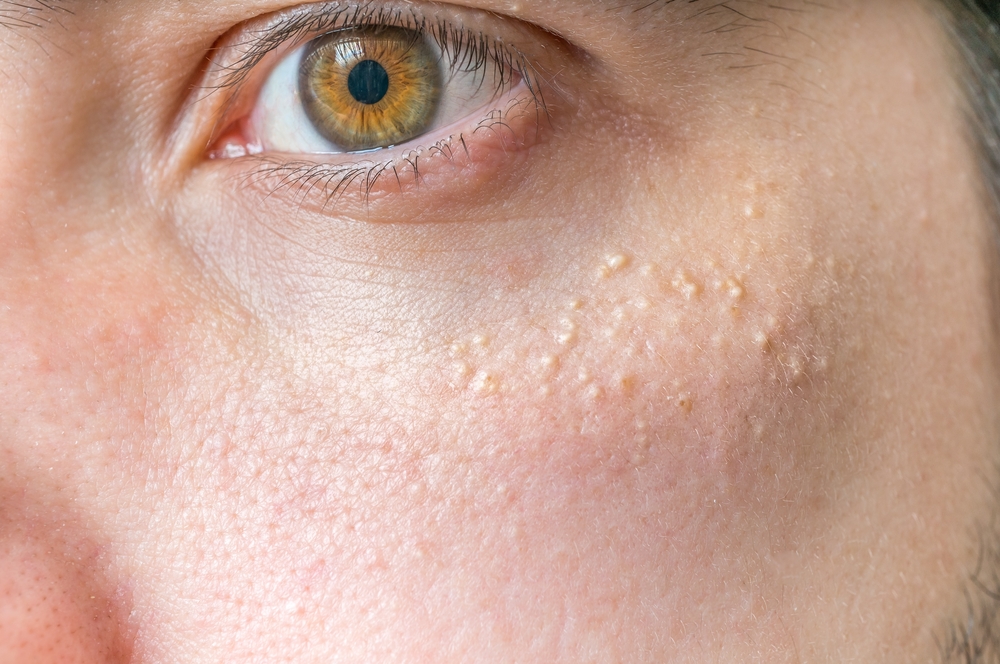Have you ever looked in the mirror and noticed tiny, pearl-like bumps under your eyes? Don’t worry, you’re not alone. These little intruders are called milia under eyes and can hinder your confidence.
Don’t worry! We’ve got you covered with a comprehensive guide on how to get rid of milia under your eyes and reclaim your radiant skin.
Table of Contents
Milia Under Eyes: What Exactly is It?
Milia are small, raised bumps that typically appear on the skin’s surface. They are tiny, pearly-white, or yellowish keratin cysts.
Milia can develop anywhere on the body, but they are most commonly present around the eyes, nose, cheeks, and forehead.
Milia occur when dead skin cells, oil, and other debris get trapped in small pockets below the skin’s surface. These pockets of trapped material are called cysts.
Unlike acne, milia do not have an opening on the skin’s surface, which makes them appear as small, firm bumps.
Milia under the eyes can be mistaken for whiteheads or other types of acne, but they are a different condition. They are often harmless and painless, but some people may find them bothersome from a cosmetic perspective.
What are the Reasons for Milia Under Eyes?
Understanding the causes of milia is the first step in effectively combating them.
Here are some common factors that contribute to the formation of milia under the eyes:
Excessive Sun Exposure
Prolonged sun exposure can damage the skin. It can also hinder the natural exfoliation, leading to dead skin cell accumulation that triggers milia formation.
Incorrect Skincare Products
Using heavy, pore-clogging skincare products or failing to cleanse your skin can create a conducive environment for Milia to thrive.
Genetics
Some individuals are genetically predisposed to developing milia. It makes them more prone to these under-eye bumps.
Suggested Read: Red Eyes Remedies to Get Bright Eyes!
Lack of Exfoliation
Inadequate exfoliation can lead to a buildup of dead skin cells, which can become trapped and result in milia.
What are the Symptoms of Milia Under Eyes?
Milia under the eyes have distinctive symptoms that make them easy to identify.
Here are the common symptoms associated with milia:
Tiny White or Yellowish Bumps
You can understand Milia by the appearance of small, raised bumps on the skin’s surface.
These bumps can be white or yellowish and are typically round or oval-shaped.
Hard Texture
Unlike pimples or whiteheads, milia have a rough texture. They often feel like small grains or beads under the skin when touched.
Localized Clusters
Milia usually form in clusters or groups rather than as isolated bumps.
This clustering is often present around the delicate skin under the eyes. However, it can also appear on other face areas.
No Redness or Inflammation
Unlike acne or pimples, milia doesn’t pose redness, inflammation, or pus-filled heads.
They tend to be relatively benign and non-inflammatory.
Suggested Read: How to Get Rid of Puffy Eyes?
Painless
Milia are typically painless and don’t cause discomfort or itching. They are primarily a cosmetic concern due to their appearance.
Slow Growth
Milia can develop slowly over time. It may persist for weeks or even months if left untreated.
Proven Hacks to Get Rid of Milia Under Eyes!
Now that we’ve unraveled the mystery behind Milia, it’s time to explore the proven hacks to bid them farewell and restore your confidence.
Gentle Cleansing
Use a mild cleanser to clean your face twice daily.
Avoid harsh exfoliants or scrubs as they can worsen the condition. Look for a non-comedogenic, hypoallergenic cleanser.
Warm Compress
To soften the skin and help open up pores, apply a warm, damp cloth to the affected area for a few minutes.
It can help loosen the trapped debris in the milia.
Sterilized Needle/Extractor
If you feel confident and the milia are prominent, consider using a sterilized needle or a milia extractor tool. Follow these steps:
- Sterilize the needle or extractor with rubbing alcohol.
- Gently prick the surface of the milia with the needle. Don’t press too hard, and don’t try to remove the entire milia at once.
- If using an extractor, gently apply pressure to the sides of the milia to encourage its contents to come out. Stop if you encounter resistance or pain.
- Once the milia gets opened, cleanse the area and apply an over-the-counter ointment to prevent infection.
Topical Retinoids
Your dermatologist might prescribe a topical retinoid cream containing ingredients like tretinoin.
These creams can help speed up the skin’s cell turnover, preventing milia from forming in the first place.
Chemical Peels
Chemical peels containing mild acids like glycolic acid can help exfoliate the top layer of skin, promoting the removal of dead skin cells and reducing milia over time.
However, always get a dermatologist to do this for you.
Microdermabrasion
This procedure uses a machine to exfoliate the outer layer of skin. It’s more intense than chemical peels and a professional should handle it.
Professional Extraction
A dermatologist or licensed aesthetician can safely extract milia using specialized tools, minimizing the risk of infection and scarring.
Laser Therapy
In some cases, laser therapy can target and break down the milia. However, get a dermatologist to do that for you.
Looking for a Dermatologist in Lahore? Reach out to Prof. Dr. Faria Asad. She is a leading Dermatologist with an experience of 28 years in dermatological practice.
Preventive Measures
To prevent new milia from forming, you should adopt a good skincare routine:
- Use non-comedogenic and hypoallergenic skincare products.
- Avoid heavy or greasy creams around the eyes.
- Protect your skin from excessive sun exposure by using sunscreen.
When to Contact A Dermatologist?
Contact a dermatologist for milia under your eyes if you’re unsure about the diagnosis, if the milia persists or worsens, with discomfort or pain, or if you have cosmetic concerns. Professional guidance can ensure accurate diagnosis and safe removal if needed.
Remember! Consistency, gentle care, and patience are your best allies in this journey.
Consult the best skin doctor in Lahore via Healthwire.
